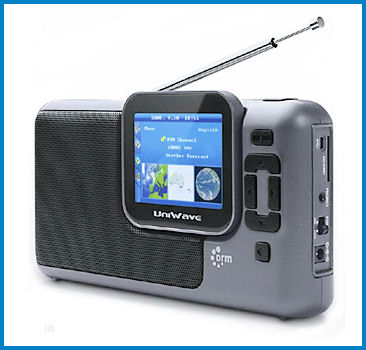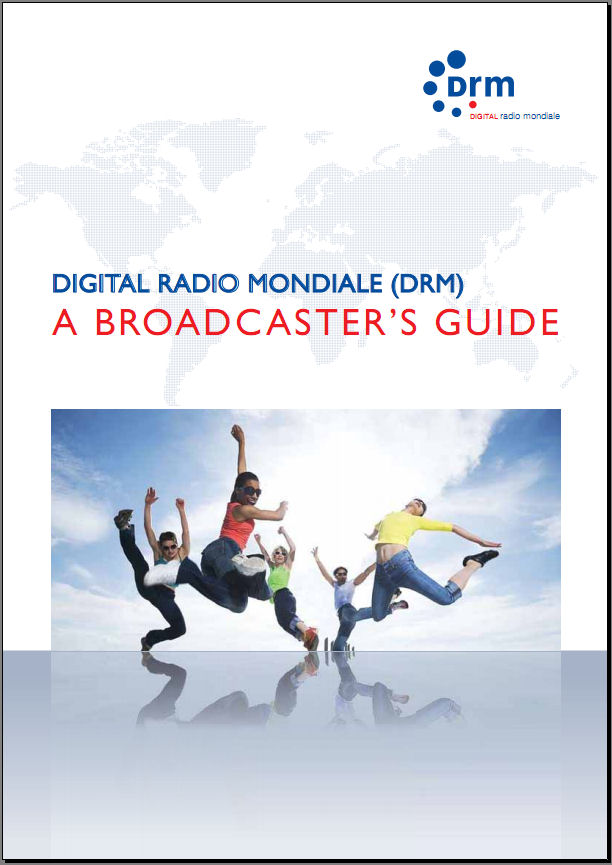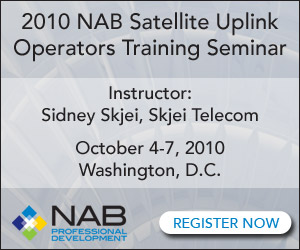|
Update
on Digital Radio Mondiale (DRM)
The broadcasting industry's transition to digital radio is a global
one. Here in the U.S., broadcasters are implementing the HD Radio
in-band/on-channel (IBOC) digital radio system, and recent statistics
compiled by iBiquity Digital Corporation (Columbia, Md.,
www.ibiquity.com), developers of HD Radio technology, suggest
that this transition is steadlily moving forward - as of June
2010:
- More than
2.5 million HD Radio receivers are in the marketplace;
- A total
of 15 automakers have publicly announced their plans to incorporate
HD Radio Technology in 86 separate vehicles, 36 featuring HD
Radio receivers as standard equipment by year end;
- Nearly 2,000
HD Radio stations are on the air in the U.S.;
- More than
1,200 new HD2/HD3/HD4 multicast channels are on the air;
- More than
100 unique HD Radio receivers are available at retail;
- More than
14,000 stores and online outlets offer HD Radio products.
Another digital
radio technology currently being implemented is called Digital
Radio Mondiale (DRM, www.drm.org).
The DRM system was developed in Europe by a consortium of broadcasters,
network providers, transmitter and receiver manufacturers, universities,
broadcasting unions and research Institutes. The original system,
standardized in 2001 (now called "DRM30") by the European Telecommunications
Standards Institute (ETSI, www.etsi.org),
was designed primarily for shortwave and international broadcasting
operating in the frequency bands below 30 MHz. In 2008 the DRM
standard was augmented with what is called "DRM+", providing support
for operation in the VHF band at frequencies up to 174 MHz, which
includes the FM broadcasting band (88-108 MHz).

Both the DRM and the HD Radio systems are considered to be "in-band" systems since they can be used within existing broadcast bands (as contrasted with "new-band" systems like the Eureka-147 DAB system, which does not fit within existing bands), and they both use coded orthogonal frequency division multiplexing (COFDM) for transmission of digital audio and associated data. For DRM, the COFDM signals consist of hundreds of subcarriers with each subcarrier being modulated using either 4-, 16-, or 64-QAM (quadrature AM) modulation. As is typically the case with digital broadcasting systems, the DRM system is extremely flexible and supports a host of operating modes. Five specific modes (A through E) are identified and summarized in the table above.
Presently,
the principal drawback of the DRM system is the near-total lack
of compatible receivers. Shown in the photo is one of the few
DRM receivers, the Uniwave Di-Wave 100. This receiver only supports
DRM30 and not DRM+. It is a "multimedia" receiver and has a 3.5"
color LCD display which can support DRM data broadcasting features
such as Electronic Program Guide (EPG). This receiver was at one
time available for purchase on the Internet at www.universal-radio.com/catalog/portable/0023.html,
however currently it is showing as "unavailable" with more units
arriving in July 2010 (and no orders are being taken at this time).

Last week,
the DRM Consortium released a new, up-to-date 88-page Broadcasters'
User Guide intended to provide a source of relevant and authoritative
information on the DRM system. It is aimed at broadcasters considering
the transition from analog to digital broadcast in the AM and
VHF broadcasting bands and should also be of interest to manufacturers,
service-planners, administrations and regulatory bodies involved
with broadcasting systems and policy. The Guide describes the
basic operation of the DRM system (DRM30 and DRM+), provides a
definitive source of references to key technical standards, including
regulatory, coordination and planning information for DRM broadcasting.
While primarily focusing on the DRM system, the Guide also includes somewhat generalized information on the transition to digital radio, including an explanation of how and why a broadcaster might go digital, from both technical and commercial perspectives. In addition, detailed information on other useful features, such as commercial applications designed to run on the DRM platform, is included. The Guide has eleven chapters with illustrations and clear explanations on themes such as the DRM technology and content, the network infrastructure, receivers, IPR and references to DRM system related papers and published articles.

A copy of
the DRB Broadcasters' User Guide is available for download
from the DRM webpage free-of-charge - go to www.drm.org/uploads/files/broadcast_manual.pdf.
The full ETSI DRM Standard, ETSI ES 201 980 V3.1.1 (2009-08),
is also available free-of-charge on the Internet - go to the ETSI
website at http://webapp.etsi.org/workprogram/Report_WorkItem.asp?WKI_ID=30464.
Another topic of current interest within the DRM community is establishing the compatibility (that is, the ability to co-exist without causing objectionable interference) of DRM+ with other transmissions, most notably with analog FM transmissions in the FM band, and with Eureka-147 DAB transmissions in VHF band III (174-230 MHz). In May 2010 a symposium was held in Germany to discuss DRM+ / DAB compatibility. A number of European broadcasters are interested in this possibility because of the broadcasting allocations that exist in VHF band III in Europe (and where a number of DAB services are presently located), however this goes beyond the range of frequencies for which DRM+ was intended
Lab measurement
and field trial results discussed at this symposium demonstrate
the feasibility of DRM+ / DAB coexistence. In addition to the
test results, information on network infrastructure and frequency
planning approaches for DRM+ in VHF band III, and implementation
of DRM+ in DAB receivers was covered as well. Additional information
on the symposium, including PowerPoint slides of the test results,
are available from the symposium website at http://drm-radio-kl.eu/symposium2010/symposium2010en.htm.
Still
Time to Save $100 on Radio Show Registration
There is still
time to save $100 on your Radio
Show registration. Today through July 4, the registration
rate which includes access to all Radio Show sessions, The Marketplace
and both luncheons is just $395 for NAB/RAB members. Additionally,
If your company is interested in the Group Promotion (register
four individuals from one company, get one free, must register
at same time) you can send an email to mailto:register@nab.org
to get a group registration code for your company. Included in
the Radio Show sessions is Ask the Experts, a series of sessions
specifically designed by NAB Science and Technology for radio
engineers and others interested in the future for radio broadcasting
from a technology perspective. You can check out the schedule
for Ask the Experts online.
The Radio Show will be held September 29 through October 1 in
Washington, D.C. Additional information on registration and housing
for the Radio Show is available on radioshowweb.com.


Radio TechCheck will not be published on July
5, but will return July 12, 2010.
June 28,
2010 Radio TechCheck is also available in an
Adobe Acrobat file.
Please click
here to read the Adobe Acrobat version of Radio TechCheck
|

